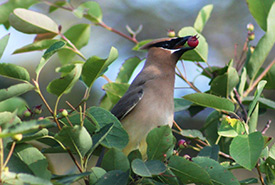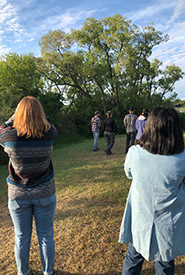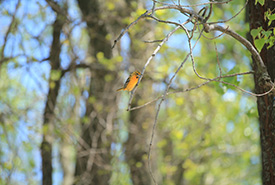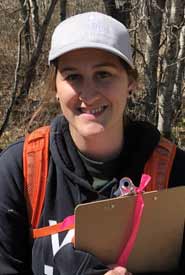Grab your binoculars and get outside

Cedar waxwing (Photo by June Swift)
Grab your binoculars and get outside. Listen, and scan the trees and sky with your eyes. That’s what I, a few fellow Nature Conservancy of Canada (NCC) interns, staff and friends did on June 14, 2019. At 6 a.m., we started out on a walk along Wascana Lake in the heart of Regina, Saskatchewan, in search of birds. Luckily for the bird amateurs like me, we had some avid birders with us. Two of our stewardship coordinators, Gabriel Foley and Marla Anderson, were there to call out the names of birds they heard singing and point out the ones in the trees for us to see.
Wascana Lake is a place I visit often with my parents, and it is amazing what you can hear and see when you stop and pay attention to the nature around you. I’ve always enjoyed being outside and listening to all the sounds of nature. Whether it is the wind whistling through the trees or the birds calling, I’m excited to finally be learning how to identify birds by their appearance and calls. If you bring along someone who is a birding guide, it’s astonishing what you can see and hear for the first time in a spot you visit quite often. You don’t even have to leave the city where you live!
Related blog posts

During our walk, we saw many different species of birds. (Photo by NCC)
During our walk, we saw many different species of birds, including some of my favourites: American yellow warbler, least flycatcher, brown-headed cowbird, eastern kingbird, and, possibly my most favourite, Baltimore oriole. Baltimore orioles are absolutely beautiful; they are bright orange and black, and easy to spot. I’ve seen them quite a few times when I’ve been out in the field, as well as when I have been out for walks around my neighbourhood. We also saw a couple of house wrens, a few American wigeons, American avocet and a flock of cedar waxwings flying above us.
One interesting thing I learned about cedar waxwings — thanks to one of the birders along with us — was that they breed late in the season compared to other birds. This is because they eat fruit, so they need to wait for when berries are their most abundant, and that is why we saw them flying in flocks, a sign that they are not breeding yet.

Baltimore oriole (Photo by Yves Cheung)
I also learned that cowbirds lay their eggs in other birds’ nests, and most birds will end up raising the cowbirds’ chicks along with their own. However, when yellow warblers find cowbird eggs in their nests, they build new nests on top of their old ones, even if their own eggs are in the nest. This makes me wonder how many new nests yellow warblers might make.
Binoculars are a great tool that can be used to enhance what you see. Binoculars can not only help you see farther, but they also help show the remarkable colours and features of the birds, which will assist you in identifying them. This summer, I encourage all of you to grab binoculars, head outside and explore a nearby park to see what birds you can find!
The Conservation Internship Program is funded in part by the Government of Canada's Summer Work Experience program.


